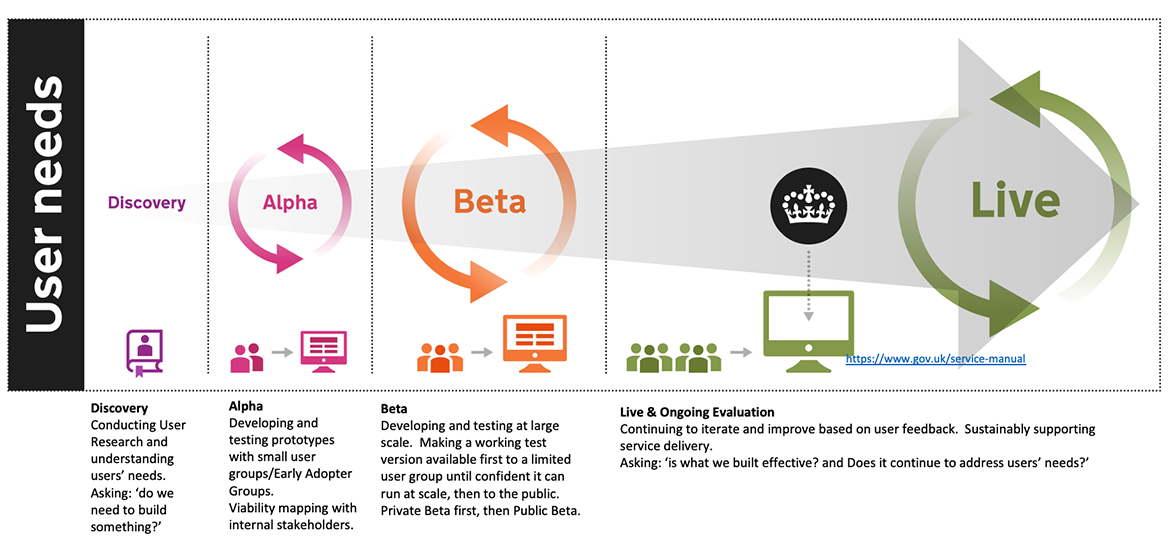Work to build a technology prototype of the Local Government Data Platform is underway and will be complete by September 2025.
This prototyping approach builds on the discovery work already undertaken and the learning gained on the current data reporting landscape in terms of data architecture and end-to-end data flow, data acquisition, orchestration, analysis, and visualisation.
Prototyping will allow us to test out solutions to the problems identified thus far in phases 1 and 2 of the project and to test potential architecture and operating models. Developing a prototype brings the strategic concept to life and will provide the evidence that we can create something that meets the users’ needs and is cost effective. It will help apprise budget and resource forecasting, which are necessary to inform any final business case.
The prototyping phase involves a 4-to-8-week discovery phase to review, digest and update the business analysis, data analysis and technical analysis outputs of the work to date, and a 12-week alpha phase to develop and test a working prototype with a small group of stakeholders. Following the alpha phase, an assessment will be undertaken to determine whether the prototype could be scaled up to a beta version, or whether further refinement and development is required at the alpha stage. The alpha phase will be critical to build up an evidence base to inform a business case, which would need to be presented to Solace and leaders for agreement, and this agreement will be needed before the project can move to a beta phase.
The technology prototype of the Local Government Data Platform will provide the opportunity to test out hypotheses, including:
- Increased insight: by managing data better, local government and partners can reuse data for various purposes, adding valuable insights.
- Timeliness of data: effective data collection can reduce the lag between when the data is collected and when it becomes available to use, improving its relevance.
- Harmonisation: aligning mechanisms and formats used for data returns can increase efficiency.
- Orchestration of processes: better orchestration can help managers understand deadlines, receive notifications, and improve the timeliness and efficiency of data returns.
- Enhanced productivity: implementing these improvements allows councils to lessen the operational load associated with submitting data returns.
- Quality improvement: enhancing data quality can lower administrative effort in error handling and improve the accuracy of the insight provided.
The IS will be responsible for delivering the discovery and alpha phases of the digital prototype and this work will be delivered within existing resources. This aligns well with the IS’ agreed role to deliver national shared service applications and technology platforms. It also complements the ambition of the Solace/IS transformation programme and the commitment to maximise the use of existing technology and digital assets within the local government family for other use purposes, maximising previous investment in technological solutions.
In parallel, the Digital Office for Scottish Local Government will be responsible for carrying out an environmental scan of other solutions and components that exist and that a Local Government Data Platform may have to integrate with and that could be used to develop an ecosystem architecture. This will include refinement of the assessment of technical and security standards that might be required, in collaboration with digital leaders. This also includes identifying potential other uses of the data exchange part of the platform that might further enhance the business case.

The diagram presents the project lifecycle approach to develop digital services.
The first phase is a discovery phase, where we will be conducting user research and understanding users’ needs.
This is followed by an alpha phase, to develop and test prototypes with early adopters. The viability of the solution is then assessed.
If the solution is deemed viable, we move to beta phase, to develop and test at large scale, making a working test version available first to a limited user group until confident it can run at scale, before opening up to the public. The beta phase usually starts with a private beta, then a public beta.
Once fully tested, the service will turn live and we will continue to iterate and improve based on user feedback, continually asking if what we have built is still effective and relevant to users.

The diagram above shows the high-level timeline of the discovery phase of the local government data platform project. The discovery phase will run between march and may 2025, and will be followed by a 12-week alpha development phase.
The discovery phase is broken down in the following sub-phases:
- Build understanding
- Define scope of prototype
- Define solution
- Closing phase
Phone: 07747 711310
-
Phase 1 Final Report
The final report of the first (discovery) phase of the project.
-
The Crerar Review
Report of the independent review of regulation, audit, inspection and complaints handling of public services in Scotland.
-
The Verity House Agreement
Partnership agreement between the Convention of Scottish Local Authorities (COSLA) and the Scottish Government “setting out our vision for a more collaborative approach to delivering our shared priorities for the people of Scotland.”